The centerpiece of the law known as the Tax Cuts and Jobs Act (TCJA), P.L. 115-97, is the permanent flat 21% tax rate on C corporations it put into effect as of Jan. 1, 2018. Considering that the top individual tax rate was dropped only to 37% (from 39.6%), even with the addition of a 20% deduction for qualified business income (QBI) that can effectively lower the rate to 29.6%, many passthrough taxpayers may be interested in possibly changing their businesses into C corporations.
However, now that the dust has settled after the TCJA’s enactment to allow a clearer view of the opportunities and pitfalls of tax planning, it seems far more advisable for many existing S corporations and partnerships to retain their passthrough-entity status rather than converting.
Although C corporations offer better deductibility of owner fringe benefits, avoidance of alternative minimum tax (AMT), the ability to choose any fiscal year end, and a lower tax rate on most dividend income, the primary driver for companies considering this shift is the new 21% rate. Upon further inspection, however, there are a number of situations where taxpayers will receive no real benefit and may in fact face a higher tax bill if they convert to a C corporation.
Clearly, smaller C corporations enjoyed effective tax rates that were lower than this under pre-TCJA law. The previous graduated C corporation rates did not rise above an effective 21% until taxable income exceeded $90,000. Further, under current law, the graduated personal income tax rates that apply to passthrough entity owners allow a significant amount of taxable income before reaching an effective 21% tax rate.
Individual taxpayers with a married-filing-jointly status who use the standard deduction will not pay a rate as high as 21% until their adjusted gross income (AGI) reaches $402,500. Assume, alternatively, that all of their income is sourced from a Schedule K-1 from a nonservice business S corporation they own but do not work at, but many others do. This would allow them the full 20% shelter of the QBI deduction on all of their income. This means they would not reach the effective tax rate of 21% until they have over $808,000 of AGI. (In both cases, assume they have no other income and are not subject to the AMT.) Based on this alternative, the pool of businesses that would benefit from the 21% C corporation tax rate is much shallower. Even a comparison based on the marginal rather than the effective tax rate would conclude that converting to a C corporation would not produce a net tax savings at some income levels. The married-filing-jointly 22% bracket (the closest one to the corporate rate) ends at taxable income of $165,000, which leaves a reasonable amount of room to pick up income before any savings would result from being taxed as a C corporation.
So the focus now should be on high-bracket individual owners. It is important to note that the C corporation rate applies only to income that is left in the company to be taxed. Transferring the cash to the owners from the company requires a deductible payment, typically in the form of compensation or rent, or a nondeductible payment, such as a dividend or a liquidating distribution.
Compensation or rent gives back all the marginal tax rate savings and may even add some payroll or net investment income tax costs. The tax rate on dividends for this income level would be 23.8%. When this rate is applied to the 79% of corporate income remaining after the corporate tax is paid, it results in a net assessment of 18.8%, before accounting for any time-value discounts. On its face, the 21% corporate tax rate plus the net 18.8% dividend tax totals 39.8%, which is higher than the 37% top rate for the owner of a passthrough entity.
The ability to pay the corporate rate now and defer the tax on dividends or liquidating distributions still may be attractive for high earners who can afford to stockpile assets in the corporation. These taxpayers, however, then have to focus on the accumulated earnings tax under Sec. 531. This tax is designed to prevent corporations from accumulating earnings in excess of the company’s reasonable business needs. There are many components to determining the company’s reasonable business needs, but it is worth noting that the safe-harbor amount allowed under Sec. 535(c)(2) has been set at $250,000 since 1982 ($150,000 for personal service corporations). This gives very little leeway for C corporations to pay the 21% tax and build up savings without dividends unless there are provable business needs to accumulate more. The accumulated earnings tax is an annual tax levied on modified taxable income (Sec. 535(b)) retained in the business in excess of its reasonable needs. Therefore, in tax years when distributions to shareholders equal or exceed modified taxable income, the accumulated earnings tax would not be imposed.
In times when earnings can be accumulated and fit under the reasonable business needs threshold, owners may also desire to continue to defer the tax until a liquidating distribution occurs, such as when the company sells its assets or its stock. The 21% rate can be paid on the gain from the asset sale, but if the funds are not required outside the corporation, it may be attractive to hold the net proceeds and invest the funds within the corporation, thus continuing the deferral of the secondary individual tax. However, in these cases, as well as when gross income from operations dwindles relative to personal holding company (PHC) income (defined in Sec. 543), taxpayers may increase their exposure to the PHC tax under Sec. 541.
The PHC tax is assessed annually on undistributed PHC income. A major distinction between the PHC tax and the accumulated earnings tax is that the PHC tax is self-assessed and more mechanical, and the accumulated earnings tax is more subjective and only assessed by the IRS. Occasionally, there may be sound planning reasons for remaining a C corporation and not liquidating and facing the PHC tax. A common example would be if the corporation has an elderly or infirm shareholder whose estate would benefit from a basis adjustment were the shareholder to die in the near term. Liquidation just after death would result in tax only on any gains inside the corporation.
Another example would be where the taxpayer has accumulated significant assets in the corporation that are now invested in passive or portfolio-type investments (post-sale). In this situation, if the taxpayer distributes current income net of the corporate tax annually, the corporation avoids both the accumulated earnings tax and the PHC tax. However, the current income is subject to double tax at a combined net maximum rate of 39.8%. Anyone who runs the numbers will find that in certain situations, it is better to pay the ongoing double tax than to distribute the accumulated earnings in a liquidation of the corporation.
Example: K sells his business in an asset sale from a C corporation. The sale netted the corporation $10,000,000 after taxes. K’s basis in the corporation stock is negligible, so the full $10,000,000, if distributed, would be subject to an individual-level tax of $2,380,000. If the $10,000,000 is retained in the company, it can be reinvested in full. If it is distributed, K would have $7,620,000 to invest. In either case, K is going to invest the proceeds in stocks that yield qualified dividends of 6% per year. If the proceeds are invested in the corporation, K would have annual after-tax cash of $409,194 ($600,000 – [$600,000 × 50% (dividends-received deduction) × 21%] – [$537,000 × 23.8%]), compared with investing the proceeds post-liquidation, which nets after-tax cash annually to K of $348,386 ($457,200 – [$457,200 × 23.8%]). In this situation, if K can survive on the net cash of $409,194, plus his other sources of income annually for the remainder of his life, it is better to retain the funds in the corporation until K’s death.
Alternatively, taxpayers sometimes consider deferring the second tax on liquidation by making an election to be taxed as an S corporation to avoid facing PHC issues. Assuming the corporation would qualify under Sec. 1361(b) to make an S election, there is a strong likelihood that it would immediately run into new issues due to the passive investment income tax under Sec. 1375. This tax applies when a corporation has accumulated C corporation earnings as of the close of a tax year and passive investment income in excess of 25% of gross receipts.
One of the bigger concerns in determining whether a corporation would even qualify to make an S election is the five-year rule under Secs. 1362(g) and 1361(b)(3)(D), which limits when a corporation, after termination of its status, can reconvert into an S corporation or a qualified Subchapter S subsidiary (QSub) without the IRS’s consent. If an S corporation revokes its S corporation status in 2018 due to the lower C corporation rates in the TCJA, it will not be able to reelect S status until 2023. In the meantime, there will be midterm congressional elections in 2018 and 2022, as well as a congressional and a presidential election in 2020. The composition of Congress could shift dramatically in this time, and the party holding the White House could also change, leading to a change in the C corporation tax rate that significantly affects tax planning. If that happens, some companies might need to let the clock tick down to 2023 before they can react.
For another possible downside, after the company reelects S status, it could face fresh exposure to built-in gains tax under Sec. 1374. This means that for five more years (2023—2027 in this example), the company would need to be careful not to recognize any built-in-gain income that would also include gains established before the S status was revoked, in the case of old S corporations that revoked the status to benefit from lower tax rates. In other words, built-in gains from an S corporation in 2017 that would have been subject to a single tax, if sold then, would have double-tax exposure for the following 10 years or more.
Another undesirable effect of revoking S status could be the loss of the company’s accumulated adjustments account (AAA) balance. In Chief Counsel Advice 201446021, the IRS asserted that when an S election terminates, the company’s AAA resets after the end of the company’s post-termination transition period (PTTP). Therefore, the IRS reasoned that if the corporation later reelects S status, its AAA starts at zero again. To avoid this situation, the entity might consider utilizing a tax-free F reorganization.
To do this, a new S corporation is formed, and the shares of the existing corporation are contributed to it to become a QSub. This makes the original corporation a disregarded entity, and the AAA is transferred to the parent under Regs. Sec. 1.1368-2(d)(2). When the QSub status is revoked to allow the corporation to be taxed as a C corporation, the AAA is intact at the parent level. If the QSub status is reestablished after five years, the AAA remains.
Alternatively, without the F reorganization, the corporation could make use of the new and enhanced PTTP rules under Sec. 1371(e). The TCJA modified these rules to still allow for distributions of money from AAA to occur within a year of the termination of Subchapter S status, but Sec. 1371(f) also extends the period to allow distributions after the PTTP to be composed of both AAA and C corporation earnings and profits on a pro rata basis. These rules appear to apply only to corporations where an election to revoke S status is filed and not to those that terminate S status due to disqualification.
Another TCJA provision may ease the decision of whether to convert from an S corporation to a C corporation. A cash-basis tax reporting S corporation may be forced to use the accrual method of accounting as a C corporation. For example, a staffing agency with $50 million in gross receipts can report on the cash basis as an S corporation, but it would need to use the accrual method as a C corporation. Typically, this change could be quite costly. To ease this pain, under Sec. 481(d)(1), there is a temporary two-year period starting on or after Dec. 22, 2017, during which any Sec. 481 adjustments from this accounting change may be taken ratably over a six-year period beginning with the year of change (versus the standard four-year period).
Even with all the pitfalls and potential for less-than-expected tax benefits from a change to a C corporation, there are still a number of factors other than the new, lower C corporation tax rates that may make a change beneficial. Certain states provide tax benefits for C corporations that are not available to other entities. For example, Ohio does not tax a C corporation’s net income. At the federal level, Sec. 1202 allows for the exclusion of up to 100% of the tax on the sale of C corporation stock that is qualified small business stock. However, the most effective way to make use of the C corporation opportunities that the TCJA created hardly seems clear-cut.
To obtain the greatest tax benefit while limiting some of the risks described above, it is likely that using a C corporation in conjunction with a passthrough entity can offer the best of both worlds. Segregating business units such as sales and marketing in a C corporation might allow taxpayers to retain modest amounts of 21% taxable income while allowing for now-nondeductible expenses, such as client and prospect entertainment costs, to have a much lower tax cost. Perhaps portions of specified service limited liability companies (LLCs) could be owned by a C corporation (being careful of the excess accumulation of earnings) to reduce the passthrough-entity income to the members and allow them to qualify for the QBI deduction. In the right circumstances, a January fiscal year-end C corporation could own 50.1% of the LLC’s profits and capital interests and force the LLC to report on the Jan. 31 fiscal year under Sec. 706(b)(4). This would not only reduce passthrough-entity income, but also create a natural tax deferral for the 49.9% still personally owned.
In the typical closely held business context, the TCJA’s reduction of corporate tax rates to a flat 21% is far from a panacea. As with almost every significant change made by the new tax law, one size seldom fits all, and the best approach requires a facts-and-circumstances-based analysis. There are many new useful tools in the tool belt and many opportunities to find favorable outcomes. The key will be determining how best to assemble them.





